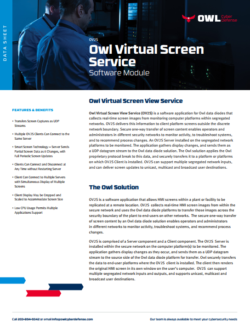 Owl Virtual Screen View Service (OV2S) is a software application for Owl data diodes that collects real-time screen images from monitoring computer platforms within segregated networks. OV2S delivers this information to client platform screens outside the discrete network boundary. Secure one-way transfer of screen content enables operators and administrators in different security networks to monitor activity, to troubleshoot systems, and to recommend process changes. An OV2S Server installed on the segregated network platforms to be monitored. The application gathers display changes, and sends them as a UDP datagram stream to the Owl data diode solution. The Owl solution applies the Owl proprietary protocol break to this data, and securely transfers it to a platform or platforms on which OV2S Client is installed. OV2S can support multiple segregated network inputs, and can deliver screen updates to unicast, multicast and broadcast user destinations.
Owl Virtual Screen View Service (OV2S) is a software application for Owl data diodes that collects real-time screen images from monitoring computer platforms within segregated networks. OV2S delivers this information to client platform screens outside the discrete network boundary. Secure one-way transfer of screen content enables operators and administrators in different security networks to monitor activity, to troubleshoot systems, and to recommend process changes. An OV2S Server installed on the segregated network platforms to be monitored. The application gathers display changes, and sends them as a UDP datagram stream to the Owl data diode solution. The Owl solution applies the Owl proprietary protocol break to this data, and securely transfers it to a platform or platforms on which OV2S Client is installed. OV2S can support multiple segregated network inputs, and can deliver screen updates to unicast, multicast and broadcast user destinations.
OV2S is a software application that allows HMI screens within a plant or facility to be replicated at a remote location. OV2S collects real-time HMI screen images from within the secure network and uses the Owl data diode platforms to transfer those images across the security boundary of the plant to end-users on other networks. The secure one-way transfer of screen content by an Owl data diode solution enables operators and administrators in different networks to monitor activity, troubleshoot systems, and recommend process changes.
OV2S is comprised of a Server component and a Client component. The OV2S Server is installed within the secure network on the computer platform(s) to be monitored. The application gathers display changes as they occur, and sends them as a UDP datagram stream to the source side of the Owl data diode platform for transfer. Owl securely transfers the data to end-user platforms where the OV2S client is installed. The client then renders the original HMI screen in its own window on the user’s computer. OV2S can support multiple segregated network inputs and outputs, and supports unicast, multicast and broadcast user destinations
